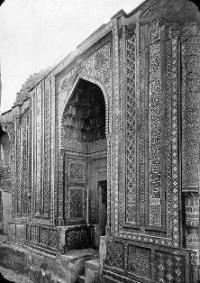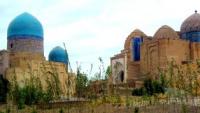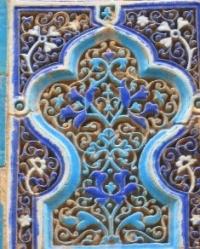You are here
Shakhi-Zinda necropolis.




Unique monuments of Uzbekistan in the Central Asia.
“The modest and chaste wives and sisters of Amir Temur expressed their will to be buried at the threshold of this place, guarded by angels, and erected such buildings here that the azure skies turned their eyes on the face of time - they did not see such beautiful and elegant buildings, such that turquoise the sky dome opened its eyes - the Moon and the Sun - he did not admire tiles of this color”
Abu Tahir Khoja.
Popular destinations Shakhi-i-Zinda in Samarkand.
Among the many spectacular historical monuments of Samarkand, there is one that stands out among its peers. On the southern outskirts of Afrosiab, the ancient town that preceded the city of Samarkand, you find Shakhi-Zinda, the necropolis.
The name Shakhi-Zinda (the living king) is connected with the grave of Kusam Ibn Abbas, who came to Samarkand in the XVII century with Arab conquerors and who was instrumental in spreading the Islamic faith.
Many a legend tell that Kusam Ibn Abbas suffered for his belief and was killed by faithless people while deep in prayer. Today 20 sites comprise the Shah I Zinda ensemble. The majority of them date from the XIV century.
Shakhi-Zinda falls under government protection as important historical and architectural heritage. Considerable archaeological research has been conducted and the facts are as follows: the Shakhi-Zinda dates back IX centuries.
Up till the XI century the territory where the monuments are located was a populated area. In the middle of the XI century the first religious buildings appeared, one of them the mausoleum of Kusam Ibn Abbas.
In 1066 Tashgach-Bagra Khan's Medresse was constructed nearby. One by one, more richly faced buildings appeared. For the facades of each grave so called carved terracotta, different types of clay, wood and three dimensional brick compositions were used.
The grave of Kusam Ibn Abbas was a sacred place where Ziarit, the worship ceremony, was held. According to one legend Kusam Ibn Abbas descended into the Shah I Zinda well and gained immortaility.
Many courageous followers tried in vain to reach the well's bottom but were deterred half way down by strange and intimidating visions and swiftly called for bystanders to pull them back up.
During Amir Temur's reign, the ruler was determined to get to the bottom of the mystery. He proclaimed among his soldiers that whoever was able to recount what he'd sighted down in that well would get as much land as he was able to circum-hike.
Khudo, a young soldier, immediately volunteered to descend. He beseeched his colleagues not to pull him up, cry and scream as he might. Though scared by the visions he held out and finally reached the bottom of the shaft.
Before his eyes an amazing paradies; beautiful gardens, noble old men sitting, drinking tea, sweet music. Khudo wondered if Kusam Ibn Abbas was among them. Just then, a grey-haired man rose and introduced himself: "I am Kusam Ibn Abbas, my son, what do you wish?" Khudo explained he was on a mission to discover the secret of Shah I Zinda.
The old man advised him not to tell what he'd witnessed and to keep the hundreds of years old secret or else he would become blind, as would his descendants. When our brave soldier was pulled up into the light of day, Amir Temur questioned him thoroughly but the only answer Khudo had was "there is absolutely nothing at the bottom of the well".
Enraged, Temur ordered for Khudo to be beheaded. Only under dire threats did Khudo finally reveal the outcome of his expedition. Amir Temur held his word and presented the soldier with as much land as he could walk or ride around. Khudo mounted his stallion and rode till horse and rider were exhausted.
His whip (kamchi) fell from his hand and he uttered: "may the boundaries of my property be right were the whip hits the ground". From then on that very place was called Kamchi. Kusam Ibn Abbas also held his word, Khudo turned blind and all his descendants to this day cannot see either.
Authority:
http://www.discovery-central-asia.com
Photos by
Alexander Petrov.







